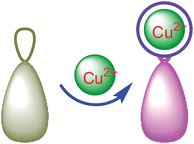Cu2+-selective naked-eye and fluorescent probe: its crystal structure and application in bioimaging†
Abstract
A new fluorescent and colorimetric Cu2+ probe was synthesized, and realized optical imaging in RAW264.7 macrophages. The design strategy was based on a change in structure between spirocyclic (non-fluorescent) and ring-open (fluorescent) forms of rhodamine-based


 Please wait while we load your content...
Please wait while we load your content...